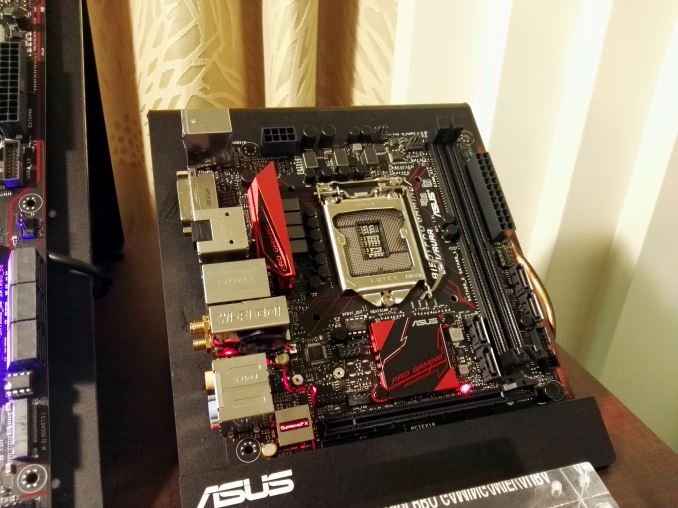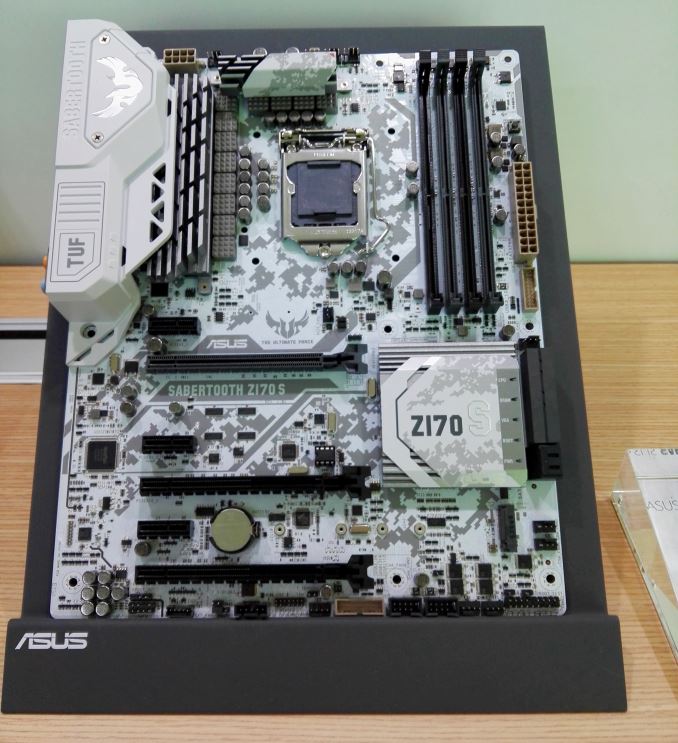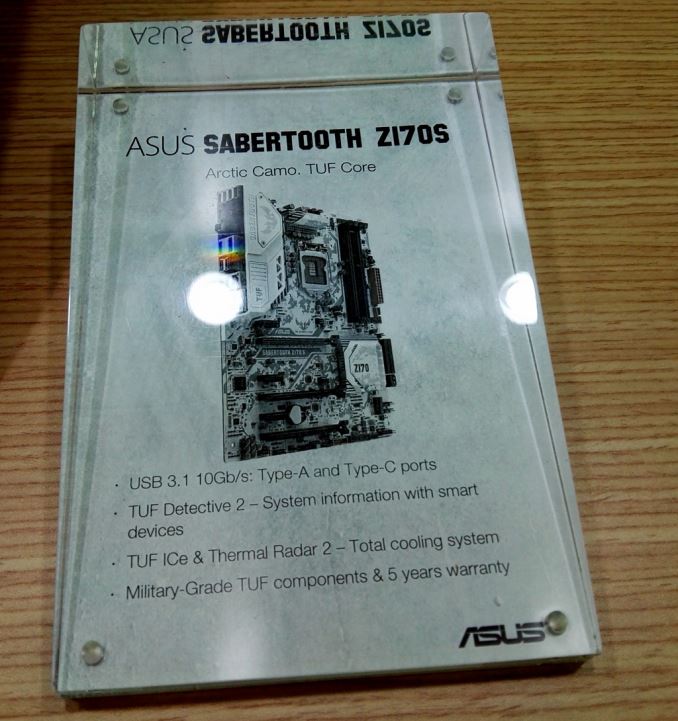ASUS Booth Tour at CES 2016: 10G Switches, External GPU Dock, USB-C Monitor and more
by Ian Cutress on January 19, 2016 9:00 AM ESTASUS Motherboards
No discussion about ASUS would be complete without talking about motherboards. We had already reported the announcement of the ASUS Maximus VIII Formula launch just before CES, featuring a pre-installed EKWB water block on the power delivery, but there were still a trio of surprises for us at the booth.
First up is the B150 Pro Gaming/Aura. As like other manufacturers, one of the things with this generation of Intel processors is moving some of the ‘gaming’ features on the high end Z series motherboards down to lower cost chipsets in order to add value. This includes styled heatsinks, a color scheme, upgraded audio in some cases, and a drive to enhanced storage or networking functionality (this board has 2x2 802.11ac with MU-MIMO for example, most likely the Qualcomm Atheros chipset). So here enters this mini-ITX motherboard, which for all intents and purposes fits the standard for a gaming motherboard.
It also comes with RGB LEDs at the bottom, hence the AURA part of the name.
Elsewhere in the booth were a couple of new motherboards not aimed specifically at the gaming crowd.
The ASUS TUF Sabertooth Z170 S (or Mark S) is the Skylake white camouflage version of the limited edition Z97 Sabertooth Mark S (read our review of unit #0001 here), except this time the Z170 version will not be limited edition. As with other motherboards in the Z170 range, this gets the upgrades for Skylake chipsets – USB 3.1 in Type A/C formats, PCIe M.2 based storage and more PCIe lanes to do things with. The Mark S is part of the TUF line, which is ASUS’ 5-year warranty line (5-years in NA, other regions may differ) and the line is usually that these boards offer components with higher durability and/or more protection as a result. The color scheme is one that ASUS feels works will with the branding, and we have seen the Mark S boards used in a number of white system builds throughout the show.
Next to the Mark S was the Z170-PREMIUM, marking a return to the high end with the Premium name for ASUS. This sits above the Deluxe, peeling bits and pieces from the Formula and Extreme. This means four USB 3.1 ports on the rear, two of which I imagine are powered by Intel’s Alpine Ridge and should support Thunderbolt 3 when validated. There is also 3x3 802.11ac dual-band WiFi, dual Intel networking, onboard U.2, support for M.2, and an extended power delivery heatsink.
Typically the Premium line also comes with a box stuffed full of extras. Back with the Z77-Premium we saw a 32GB mSATA drive as part of that bundle, though we might instead see here either a U.2 cable or a pair of front panel USB 3.1 boxes to use up all the SATA Express connectors. It will be interesting to watch, and it certainly won’t come cheap.


















50 Comments
View All Comments
DanNeely - Tuesday, January 19, 2016 - link
Is the back of that phone actually made up of a bunch of triangular panels at angles to each other; or does the finish just fake the look?WorldWithoutMadness - Tuesday, January 19, 2016 - link
It is 3D (source http://www.androidcentral.com/hands-asus-zenfone-2...Panzerknacker - Tuesday, January 19, 2016 - link
I just dont understand why did 10G never become mainstream and is it so damn expensive? Back when 100mbit was mainstream the price of 1G was higher but nowhere near $760 for a switch. 1g is now mainstream for a decade or so, what takes it so long? Did we reach the limit of copper networking? I mean, in datacenters there has to be a enormous market for fast networking, I cannot understand why prices are still so high because on a huge market you would expect a lot a competition and fast development of hardware. Or did they completely move to different networking standards in datacenters, like fibre?Reflex - Tuesday, January 19, 2016 - link
Power consumption is very high compared to gigabit, and wireless replaced ethernet for most home and small office use, thus negating economies of scale which normally would drive prices down.Lieuchikaka - Thursday, June 2, 2016 - link
http://mavangvn.vn/ma-vang-dien-thoai/dien-thoai-s...TwistedKestrel - Tuesday, January 19, 2016 - link
It's mostly the ubiquity of 1GbE vs the handful of vendors making 10GbE parts. 1GbE PHYs are cheap as dirt, and 10GbE is two orders of magnitude more expensive... and there aren't that many people that want it yet. Once 1Gb+ throughput on 802.11ac radios becomes more commonplace instead of mostly theoretical, that would be something of a driver for consumer 10GbE.Interesting that a few US ISPs have upcoming or available service in excess of 1Gb, I wonder what kind of connections their equipment would have
DanNeely - Tuesday, January 19, 2016 - link
For consumer service, I'd be really surprised if it was anything but a combined modem/pretend it actually is able to achieve multi-gigabit speeds wifi router.iwod - Tuesday, January 19, 2016 - link
They have new standard NBase-T which provides 2.5Gbps and 5Gbps on Normal CAT 6 Cable. But no idea why no company are getting products out.Alex_M - Wednesday, January 20, 2016 - link
The real benefits for NBase-T will be 2.5/5 Gbps over exisitng Cat5e (not Cat6) upto 100m. It means we don't have to replace all those existing cable runs to benefit from the higher speed. Its fairly new but I hear that the silicon has started sampling....Lieuchikaka - Thursday, June 2, 2016 - link
http://mavangvn.vn/ma-vang-dien-thoai/dien-thoai-s...